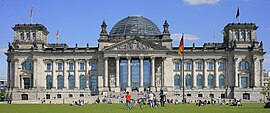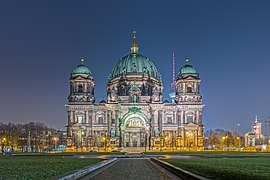Berlin: Federated state, capital and largest city of Germany
Berlin (/bɜːrˈlɪn/; German: (listen)) is the capital city of Germany.
It is the largest city in the European Union by population, with around 3.9 million people in 2024. Berlin residents come from about 190 different countries.
Berlin | |
|---|---|
| From top, left to right: Berlin center, Reichstag; Brandenburg Gate; Potsdamer Platz; Gendarmenmarkt | |
| Coordinates: 52°31′12″N 13°24′18″E / 52.52000°N 13.40500°E | |
| Country | |
| State | Berlin |
| Government | |
| • Body | Abgeordnetenhaus of Berlin |
| • Governing Mayor | Franziska Giffey (SPD) |
| Area | |
| • City/State | 891.7 km2 (344.3 sq mi) |
| Elevation | 34 m (112 ft) |
| Population (31 December 2019) | |
| • City/State | 3,769,495 |
| • Urban | 4,473,101 |
| • Metro | 6,144,600 |
| Demonyms | Berliner(s) (English) |
| Time zone | UTC+01:00 (CET) |
| • Summer (DST) | UTC+02:00 (CEST) |
| Area codes | 030 |
| Geocode | NUTS Region: DE3 |
| GDP (nominal) | €155 billion (2020) |
| GDP per capita | €41,000 (2020) |
| GeoTLD | .berlin |
| HDI (2018) | 0.950 very high |
| Website | www |
The city is in the eastern part of Germany in Central Europe and is surrounded by many forests and lakes. Berlin has an area of 891 km2 (344.02 sq mi). The rivers Havel, Dahme and Spree run through Berlin. It has a temperate climate.
Berlin is home to many famous buildings and monuments, like the Siegessäule, the Brandenburger Tor, the Reichstag and the boulevard Unter den Linden. On the boulevard is the Humboldt University. The city has many nightlife options.
Berlin is an important city for the history of Germany. The King of Prussia and the Emperor of Germany lived in Berlin. The government of Germany was in Berlin for many years. Bombs destroyed many buildings in the city in World War Two. The city was split into West Berlin and East Berlin after World War Two. After the Berlin Wall was built in 1961 very few people were allowed to cross from East Berlin into West Berlin. The wall divided the city until 1989 when the East German government decided to allow anyone to cross, and people decided to tear down the wall.
Berlin is a world city of culture, start ups, politics, media and science. There are a lot of technology companies in the city. They are important for the city's economy. Many planes and trains travel to and from Berlin because the city is an important place for tourism and business.
History
- 1244: The first writings about a place called Berlin.
- 1451: The Hohenzollern family moved to Berlin as the place to rule their country.
- 1618–48: After the Thirty Years' War in Germany, the number of people that lived in Berlin dropped to only 6000.
- 1701: Berlin became capital of Prussia.
- 1709: Berlin and its neighbor city Cölln (not Köln/Cologne) are combined to form the new Berlin.
- 1806: The army of Napoleon Bonaparte moved into Berlin.
- 1871: Berlin became capital of the German Empire.
- 1920: The Old Berlin and some neighbour towns are combined into "Greater Berlin" (Groß-Berlin).
- 1945: The town is divided into four sectors, used by the allies of World War II. There is a Soviet Sector, an American Sector, a British Sector and a French Sector.
- 1949: After foundation of the two Germanies, the town is still divided. There is now West Berlin and East Berlin.
- 1961: The Berlin Wall was built by the communist government of East Germany between the two halves of Berlin.
- 1990: After German reunification, the Berlin Wall is torn down, and there is only one Berlin again. The new Berlin becomes the capital of one Germany.
- 2001: 23 boroughs of Berlin were changed into 12.
- 2006: The FIFA World Cup Final is held in Berlin at Olympiastadion.
People

In 2018, Berlin had 3.75 million registered inhabitants in an area of 891.1 km2 (344.1 sq mi). The city's population density was 4,206 inhabitants per km2. Berlin is the most populous city in Germany and the European Union. The entire Berlin-Brandenburg capital region has a population of more than 6 million in an area of 30,546 km2 (11,794 sq mi). More than 2.0 million households were counted in the city. Around 60 percent of them were single-person households.
There are more than 20 communities with a population of at least 10,000 people in 2019, including German, Turkish, Polish, Syrian, Italian, Bulgarian, Russian, Lebanese, Palestinian, Serbian, Bosnian, Vietnamese, American, Romanian, Croatian, Chinese, Austrian, Ukrainian, French, British, Spanish, Israeli, Indian and Iranian communities.
In 2019, there were 777,345 registered residents of foreign nationality and another 542,975 German citizens with a "migration background", meaning they or one of their parents immigrated to Germany after 1955. Berlin residents originate from about 190 different countries.
Geography
Berlin is in northeastern Germany, in an area of low-lying marshy woodlands with a mainly flat terrain. It is part of the Northern European Plain. The river Spree and Havel are the two main rivers in the city. In Spandau, a borough in the west of Berlin, the Spree empties into the river Havel, which flows from north to south through western Berlin. The largest lakes being the Tegeler See, the Großer Wannsee and the Großer Müggelsee.
The Arkenberge hills in Pankow at 122 meters (400 ft) elevation are the highest point in Berlin. The Müggelberge (mountains) at 114.7 meters (376 ft) elevation is the highest natural point and the lowest is the Spektesee in Spandau, at 28.1 meters (92 ft) elevation.
Boroughs

Education

Berlin is one of the most renowned centers of higher education and research in Germany and the world. Historically, 57 Nobel Prize winners are affiliated with the Berlin-based universities.
The city has four universities and more than 40 private, professional, and technical colleges in 2020. Around 200.000 students were enrolled in 2019. Among them around 20% have an international background.
The three largest universities combined have approximately 110,000 students. There are the Free University of Berlin (Free University of Berlin, FU Berlin) with about 35,000 students, the Humboldt University of Berlin (HU Berlin) with 40,000 students, and the Technical University of Berlin (TU Berlin) with 35,000 students. The Charité Medical School has around 9,000 students. The Berlin University of the Arts (UdK) has about 4,000 students and the ESMT Berlin is a leading business schools in Germany. The Berlin School of Economics and Law (HWR) has an enrollment of about 11,000 students, the Berlin University of Applied Sciences and Technology (BHT) of about 12,000 students, and the Hochschule für Technik und Wirtschaft (University of Applied Sciences for Engineering and Economics, HTW) of about 14,000 students.
Nobel Prize winners


|
|
Culture

Berlin is famous for its numerous cultural institutions, many of which enjoy international reputation. It is a trendsetting city. Young people, creatives and entrepreneurs continue to settle in the city and make Berlin a popular entertainment center in the world.
Landmarks
- Alexanderplatz
- Berliner Dom (Berlin's cathedral)
- Berlin Hauptbahnhof (Main Railway station)
- Brandenburg Gate
- East Side Gallery (Former Berlin Wall)
- Fernsehturm (TV tower - the highest building in Germany)
- Potsdamer Platz
- Reichstag building (home of the Bundestag)
- Rotes Rathaus (office of the Governing Mayor)
- Siegessäule (Statue of Victory)
- Tiergarten (Central Park)
- Unter den Linden (Main boulevard)
- The Theatre of the West
- Bellevue Palace
- Victory column
- Alte Nationalgalerie
- Berlin Philharmonic
- Oberbaumbrücke
- Berliner Dom (Berlin cathedral)
Cuisine
The Berlin cuisine and culinary offerings vary greatly. 23 restaurants in Berlin have been awarded one or more Michelin stars in 2021, which ranks the city at the top for the number of restaurants in Germany.
Many local foods originated from north German culinary traditions and include rustic and hearty dishes with pork, goose, fish, peas, beans, cucumbers, or potatoes. Typical Berliner fare include popular street food like the Currywurst Buletten (meat balls) and the Berliner doughnut, known in Berlin as Pfannkuchen. German bakeries offering a variety of breads and pastries are widespread. One of Europe's largest delicatessen market is found at the department store KaDeWe. Among the world's largest chocolate stores is Fassbender & Rausch.
Berlin is also home to a diverse gastronomy scene reflecting the immigrant history of the city. Immigrants brought their culinary traditions to the city, such as the varied fast-food version of the doner kebab. Asian cuisine like Chinese, Vietnamese, Thai, Indian, Korean, and Japanese restaurants, as well as Spanish tapas bars, Italian, and Greek cuisine, can be found in many parts of the city.
- Berliner Pfannkuchen
- Doner Kebab
- KaDeWe chocolate
- Borchardt restaurant
Economy

In 2018, the GDP of Berlin totaled €147 billion. The city is the largest metropolitan economy in Germany and the third largest in the European Union. Berlin's economy is dominated by the service sector, with around 85% of all companies doing business in services. In 2019, the total labor force in Berlin was about 2.0 million.
Important economic sectors in Berlin include life sciences, transportation, information and communication technologies, media and music, advertising and design, biotechnology, environmental services, construction, e-commerce, retail, hotel business, and medical engineering.
Research and development are important for the city. Berlin is part of the Eurozone.
Creative industries

The creative arts and entertainment business is an important part of Berlin's economy. The sector comprises music, film, advertising, architecture, art, design, fashion, performing arts, publishing, R&D, software, TV and radio.
In 2014, around 30,500 creative companies operated in the Berlin-Brandenburg metropolitan region, predominantly medium-sized enterprises. Generating a revenue of 15.6 billion Euro and 6% of all private economic sales, the culture industry grew from 2009 to 2014 at an average rate of 5.5% per year.
Berlin is an important center in the European and German film industry. It is home to more than 1,000 film and television production companies, 270 movie theaters, and around 300 national and international co-productions are filmed in the region every year. The Babelsberg Studios and the production company UFA are adjacent to Berlin in Potsdam. The city is also home of the German Film Academy (Deutsche Filmakademie), founded in 2003, and the European Film Academy, founded in 1988.
Business
Many German and international companies have business or service centers in the city. For several years Berlin has been recognized as a major center of business founders. In 2015, Berlin generated the most venture capital for young startup companies in Europe.
Among the 10 largest employers in Berlin are the City-State of Berlin, Deutsche Bahn, the hospital providers Charité and Vivantes, the Federal Government of Germany, the local public transport provider BVG, Siemens, Deutsche Telekom and the e-commerce firm Zalando.
Sister cities
Berlin has partnerships with 17 cities. Each of the 12 boroughs also has their own sister cities.
|
|
References
Other websites

- Official page www.berlin.de
- Berlin Sightseeing Tours
- EXBERLINER – English City Magazine
- Berlin City Panoramas – panoramic views and virtual tours
This article uses material from the Wikipedia Simple English article Berlin, which is released under the Creative Commons Attribution-ShareAlike 3.0 license ("CC BY-SA 3.0"); additional terms may apply (view authors). Content is available under CC BY-SA 4.0 unless otherwise noted. Images, videos and audio are available under their respective licenses.
®Wikipedia is a registered trademark of the Wiki Foundation, Inc. Wiki Simple English (DUHOCTRUNGQUOC.VN) is an independent company and has no affiliation with Wiki Foundation.







































